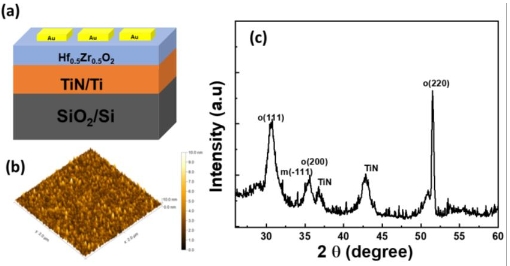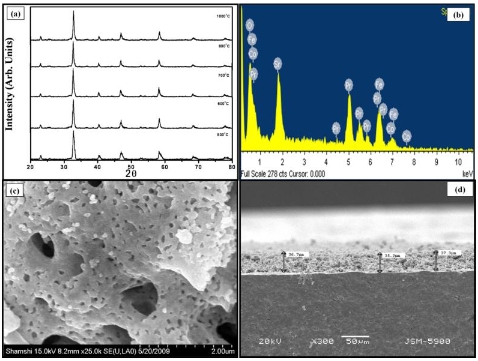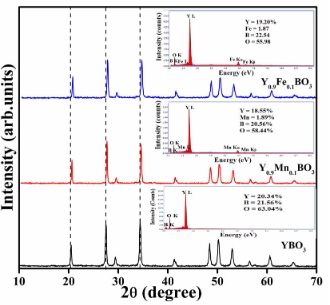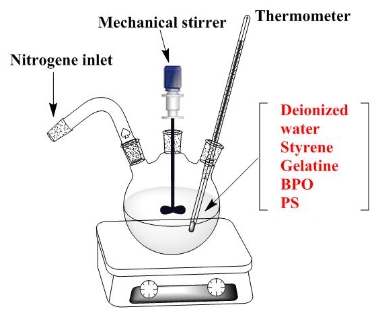Preparation and characterization of CuBO2-based photocatalysts and doped variants
Abstract
An eco-friendly CuBO2-based photocatalyst has been doped by a lanthanide for the first time. Gd3+ and Gd3+/Bi3+-doped CuBO2 are synthesized by the hydrothermal method to study their magnetic properties. Then they are analyzed by XRD, UV-Vis, SEM, and VSM. The maximum amount of doping is x= 0 − 1.5% in Cu1–3xGd3xBO2 and Cu1–3xBi3x/2Gd3x/2BO2 formulas as they are analyzed in XRD. For concentrations higher than x = 2%, the additional peak indicates that doping is incomplete. The XRD pattern of CuBO2 confirms that its crystal structure is a hexagonal one with the R3 ̅m space group. According to UV-Vis analysis, the bandgap energies are 2.711, 2.753, and 2.765 for CuBO2 and doped systems. Additionally, the morphology of particle sizes is confirmed according to SEM images. Meanwhile, the magnetic properties of synthesized material are studied by VSM, and the doped compound exhibited higher magnetic properties than CuBO2, which is associated with the exchange interaction of electron and d spins in Gd3+ and Bi3+. The study aims to provide insights into the magnetic properties of lanthanide-doped CuBO2-based photocatalysts, potentially paving the way for developing improved magnetic materials for various applications.
References
[1]Santra S, Das NS, Chattopadhyay KK. Wide band gap p-type nanocrystalline CuBO2 as a novel UV photocatalyst. Materials Research Bulletin. 2013; 48(7): 2669–2677. doi: 10.1016/j.materresbull.2013.03.034
[2]Snure M, Tiwari A. CuBO2: A p-type transparent oxide. Applied Physics Letters. 2007; 91(9). doi: 10.1063/1.2778755
[3]Zheng Y, Wang Z, Tian Y, et al. Synthesis and performance of 1D and 2D copper borate nano/microstructures with different morphologies. Colloids and Surfaces A: Physicochemical and Engineering Aspects. 2009; 349(1–3): 156–161. doi: 10.1016/j.colsurfa.2009.08.012
[4]Scanlon DO, Walsh A, Watson GW. Understanding the p-Type Conduction Properties of the Transparent Conducting Oxide CuBO2: A Density Functional Theory Analysis. Chemistry of Materials. 2009; 21(19): 4568–4576. doi: 10.1021/cm9015113
[5]Bolsunovskaya O, Popov M, Petrakovskii G, et al. Magnetic structure and elementary excitation spectra of copper metaborate. Journal of Magnetism and Magnetic Materials. 2006; 300(1): e392–e394. doi: 10.1016/j.jmmm.2005.10.127
[6]Roessli B, Schefer J, Petrakovskii GA, et al. Formation of a Magnetic Soliton Lattice in Copper Metaborate. Physical Review Letters. 2001; 86(9): 1885–1888. doi: 10.1103/physrevlett.86.1885
[7]Kipcak AS, Senberber FT, Aydin Yuksel S, et al. Synthesis, characterisation, electrical and optical properties of copper borate compounds. Materials Research Bulletin. 2015; 70: 442–448. doi: 10.1016/j.materresbull.2015.05.003
[8]Mero RD, Lai CH, Du CH, et al. Spectroscopic Signature of Spin–Charge–Lattice Coupling in CuB2O4. The Journal of Physical Chemistry C. 2021; 125(7): 4322–4329. doi: 10.1021/acs.jpcc.1c00111
[9]Khanh ND, Abe N, Kubo K, et al. Magnetic control of electric polarization in the noncentrosymmetric compound (Cu,Ni)B2O4. Physical Review B. 2013; 87(18). doi: 10.1103/physrevb.87.184416
[10]Molchanova AD, Boldyrev KN, Erofeev AS, et al. Magnetic phase transitions and linear magnetic dichroism in manganese-doped copper metaborate (Cu,Mn)B2O4. Journal of Physics: Conference Series. 2017; 917: 072003. doi: 10.1088/1742-6596/917/7/072003
[11]A.D. Molchanova, E.M. Moshkina, M.S. Molokeev, E.V. Tropina, A.F. Bovina, K.N. Boldyrev, Synthesis and optical properties of nickel-doped copper metaborate crystals, Opt. Spectrosc. 2022, 130.
[12]Giri S, Trewyn BG, Stellmaker MP, et al. Stimuli—Responsive Controlled—Release Delivery System Based on Mesoporous Silica Nanorods Capped with Magnetic Nanoparticles. Angewandte Chemie International Edition. 2005; 44(32): 5038–5044. doi: 10.1002/anie.200501819
[13]Bergemann C, Muller-Schulte D, Oster J, et al. Magnetic ion-exchange nano- and microparticles for medical, biochemical and molecular biological applications. J. Magn. Magn. Mater. 1999; 194: 45.
[14]Nunez L, Kaminski MD. Transuranic separation using organophosphorus extractants adsorbed onto superparamagnetic carriers. J. Magn. Magn. Mater. 1999; 194: 102.
[15]Ellis MC. Understanding Magnetic and Optical Properties of Lanthanide-Doped Oxide Nanospinels and Heterometallic Formate Metal-Organic Frameworks [PhD thesis]. Florida State University Libraries; 2020.
[16]Reisfeld R. Optical Properties of Lanthanides in Condensed Phase, Theory and Applications. AIMS Materials Science. 2015; 2(2): 37–60. doi: 10.3934/matersci.2015.2.37
[17]Brik MG, Srivastava AM. 1.8 Electronic properties of the lanthanide ions. Rare Earth Chemistry. 2020: 83–96. doi: 10.1515/9783110654929-008
[18]Kurzen H, Bovigny L, Bulloni C, et al. Electronic structure and magnetic properties of lanthanide 3+ cations. Chemical Physics Letters. 2013; 574: 129–132. doi: 10.1016/j.cplett.2013.04.070
[19]Sorace L, Gatteschi D. Lanthanides and an Actinides in molecular magnetism 1st ed. In:Electronic Structure and Magnetic Properties of Lanthanide Molecular Complexes. Wiley-VCH Verlag GmbH & Co. KGaA; 2015.
[20]Ncube S, Coleman C, Strydom A, et al. Kondo effect and enhanced magnetic properties in gadolinium functionalized carbon nanotube supramolecular complex. Scientific Reports. 2018; 8(1). doi: 10.1038/s41598-018-26428-y
[21]Serga V, Burve R, Maiorov M, et al. Impact of Gadolinium on the Structure and Magnetic Properties of Nanocrystalline Powders of Iron Oxides Produced by the Extraction-Pyrolytic Method. Materials. 2020; 13(18): 4147. doi: 10.3390/ma13184147
[22]Bae J, Shin D, Jeong H, et al. Highly Water-Resistant La-Doped Co3O4 Catalyst for CO Oxidation. ACS Catalysis. 2019; 9(11): 10093–10100. doi: 10.1021/acscatal.9b02920
[23]Santra S, Das NS, Maiti S, et al. Wide band gap p-type CuBO2 nanostructures by hydrothermal route and fabrication high quality p-CuBO2/n-ZnO nano-heterojunction. Chemical Physics Letters. 2014; 604: 97–100. doi: 10.1016/j.cplett.2014.04.052
[24]Ruttanapun C. Optical and electronic properties of delafossite CuBO2 p-type transparent conducting oxide. Journal of Applied Physics. 2013; 114(11): 113108. doi: 10.1063/1.4821960
[25]Santra S, Das NS, Chattopadhyay KK. Sol–gel synthesis and characterization of wide band gap p-type nanocrystalline CuBO2. Materials Letters. 2013; 92: 198–201. doi: 10.1016/j.matlet.2012.10.094
[26]Connors KA. The Phenomenological Theory of Solvent Effects in Mixed Solvent Systems. Handbook of Solvents. 2014: 467–490. doi: 10.1016/b978-1-895198-64-5.50013-1
[27]Madhusudan KR, Manorama SV, Ramachandra RA. Bandgap studies on anatase titanium dioxide nanoparticles. Mater. Chem. Phys. 2003; 78: 239.
[28]Morales AE, Mora ES, Pal U. Use of diffuse reflectance spectroscopy for optical characterization of un-supported nanostructures. Rev. Mex. de Fis. 2007; 53: 18.
Copyright (c) 2024 Soheila Azordeh, Mehdi Asadi, Abdolali Alemi

This work is licensed under a Creative Commons Attribution 4.0 International License.










